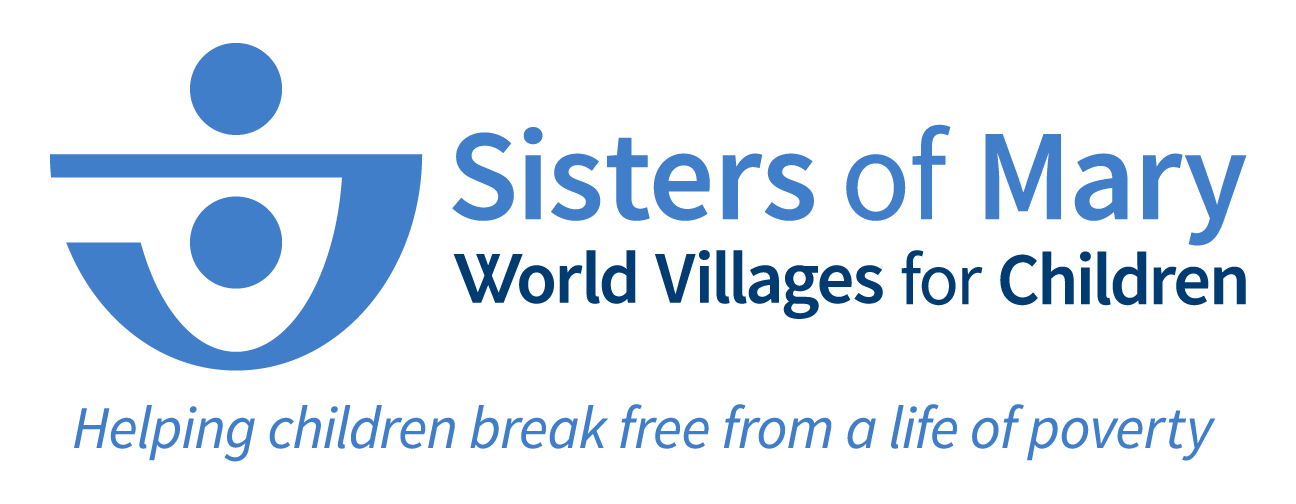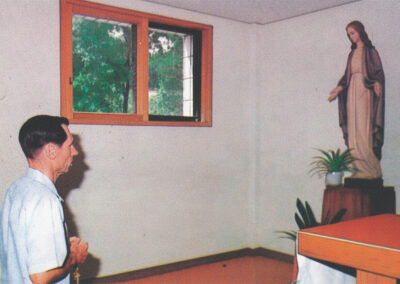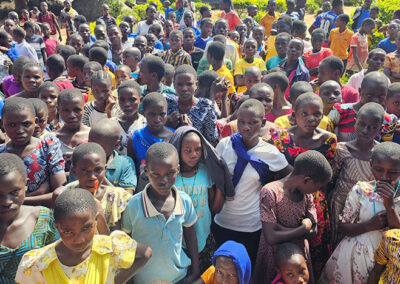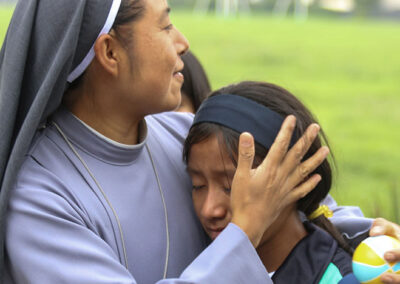As you read this sentence, a remarkable event is unfolding in a small golfing village named Hobe Sound on the eastern coastline of Florida. Martin Kavanaugh, one of the most influential men in the Professional Golf Association over the past four decades, is learning how to die; he is spending the Advent season grappling with the ferocious manner of the saints and spiritual titans, who offered their lives to God as a holocaust.

Martin Kavanaugh
It has been nothing short of a wonderful life for Kavanaugh, a 77-year-old married father of three and grandfather of seven who’s spent a lifetime playing and working alongside the greatest golfers in the world. A Type-A personality and humble hard-charger from birth, he noticed earlier this year that his drives and short shots were continually losing distance. He visited a doctor and learned he was in the grip of Amyotrophic lateral sclerosis (ALS), commonly known as Lou Gehrig’s Disease. There is no cure for the disease that causes total loss of muscle function. Life expectancy is two to five years.
His thoughts turned to the agonized Christ, and how his relationship with Him would soon be intensifying. In his world of being surrounded by strong and able-bodied athletes, not a single one could offer thoughts on suffering and dying like a saint.
Then one day in November, a deceased priest, Venerable Aloysius Schwartz, emerged in his life like Scrooge’s ghost from Christmas Past. And suddenly, on this mid-December day, the mysterious priest has become an icon in Kavanaugh’s soul. In merely fifty days, the missionary priest from Washington D.C. has shifted the old golfer’s entire life.

The overnight metamorphosis began when a deacon from his parish, St. Jude in Tequesta, handed Kavanaugh a first-class relic of Schwartz, who was elevated to Venerable by Pope Francis in 2016. The tiny relic started a movement that has Kavanaugh suddenly resembling Fr. Al – in his diminished physical state and his day-to-day manner. What does it mean to resemble a man on the path to canonization?
Recently, after falling to the ground and cracking his C-7 vertebrae, Kavanaugh offered his excruciating pain to God like a grunted-out puff of incense. God, use this little agony as you see fit. My pain is yours.
 As his wife, Diane, cleans, dresses, bathes, and helps him into bed, he offers his indignity and powerlessness to God. Lord, Diane has suddenly become my rock. She is the strong one now. God, thank you for this strong and giving wife of mine. Help me to surrender to her new role for me in total humility.
As his wife, Diane, cleans, dresses, bathes, and helps him into bed, he offers his indignity and powerlessness to God. Lord, Diane has suddenly become my rock. She is the strong one now. God, thank you for this strong and giving wife of mine. Help me to surrender to her new role for me in total humility.
When his fifth-grade CCD students questioned his neck brace, slower walk, and softer voice, he said aloud – “God has great things in store for me!” – then softly said to himself – God, it is worsening now. But thank you for this cross, and for giving me the chance to work out my salvation through it.
When neighbors call out on his slow walks around the neighborhood, he smiles with cheerfulness and says, “I feel great.” Marty Kavanaugh hasn’t felt “great” in a very long time. But he wouldn’t dare tell a soul. Fr. Al would never advise it.
“Fr. Al wrote about the futility of moaning and groaning. He said verbally speaking of the pain and frustration is of no use, and just makes things worse,” Kavanaugh said. “He said it’s better to just keep the pain to oneself, like grunting interiorly rather than letting anyone know.
“I am now living the mystery of the cross. It’s funny, sometimes I can’t believe it’s me. But what a gift to be able to suffer from ALS alongside a man, Fr. Al Schwartz, who also suffered from it. He has become my newest friend. I feel like He’s suddenly rolled out the red carpet and given me the blueprint on how to suffer. I would collapse under the weight of this without my Catholic faith and the newly discovered help of this saint.”
 Six weeks ago, Kavanaugh had no idea who Fr. Al was, or that he started Korean Relief in the wake of the Korean War as a way to save orphans, the abandoned, and the poorest of the poor. Today, Fr. Al’s once-meager start-up for the rejected ones of South Korea – known as Sisters of Mary World Villages For Children – cares for more than 20,000 children in Boystown and Girlstown communities in six different countries. The priest’s sacrificial work, accompanied by the Sisters of Mary, has helped 175,000 teenagers graduate from high school in their five-year boarding schools.
Six weeks ago, Kavanaugh had no idea who Fr. Al was, or that he started Korean Relief in the wake of the Korean War as a way to save orphans, the abandoned, and the poorest of the poor. Today, Fr. Al’s once-meager start-up for the rejected ones of South Korea – known as Sisters of Mary World Villages For Children – cares for more than 20,000 children in Boystown and Girlstown communities in six different countries. The priest’s sacrificial work, accompanied by the Sisters of Mary, has helped 175,000 teenagers graduate from high school in their five-year boarding schools.
In early November, after Kavanaugh was given the first-class relic of Fr. Al – who died from the disease in 1992 – his life began to change. The gift of the relic led Kavanaugh to read Fr. Al’s biography and end-of-life autobiography, Killing Me Softly: The Inspiring Story of a Champion of the Poor. He finished the final chapter of the autobiography at a Holy Hour last week. With candle light reflecting off the monstrance, Kavanaugh read violent words – descriptions of choking sensations, excruciating pain, and sleepless nights followed by daytime “comas of sleepiness.” He read the words of a priest who admitted to total helplessness.
He also read these words: I will do my best and try to take it one day at a time.
So that is what Kavanaugh is attempting to do.

The PGA Hall of Famer, master instructor, and builder of some of America’s finest golf courses was raised in the Catholic faith and taught the power of redemptive suffering. But until Fr. Al’s piercing words on handling the violence of suffering broke into him., Kavanaugh was struggling to sort out a disorienting wilderness of trying to offer his pain and diminishing body to God.
In November, he opened the mail one day and pulled out Killing Me Softly, which Fr. Al wrote just weeks before dying in the Philippines at the age of 62. He read Fr. Al’s words in a daze. As he went from page to page, he realized his life was being changed by an uncommon priest who had embraced the crucifixion of his withered body. A saint was showing him how to die in total submission to God.
“Reading that book has become perhaps the most impactful thing that has ever happened to me,” he said. “Fr. Al has become my exemplar. His words were showing me how to get prepared to face all that is coming. It was like I could very clearly hear him say to me, ‘Now, Marty, this is going to get a lot worse – so get ready.’
“It would be easy for me to sit around and feel sorry for myself – but did Fr. Al? No – he didn’t. He was a man who was changing the world and having a positive influence on hundreds of thousands of lives, and he was struck down with ALS at the age of 62 — and he accepted it as if was from God.
“And you think to yourself: ‘Why in the world would ALS be allowed for this man?’ But he knew it was the mystery of the cross. … so for me now, there is just acceptance without feeling sorry for myself.
“I didn’t want the book to end, because I know how the book ends.”
In reading and researching Fr. Al’s life, Kavanaugh discovered the Sisters of Mary, the religious order the American priest founded in 1964 to help mother the orphans of Busan, Korea. Today, the sisters are considered one of the hardest-working religious communities in the world. Each day, 383 sisters awaken before dawn, where they begin to beg God to help sustain them to give the full measure of their love to once-bullied boys and girls. They know these children will leave for universities, workplaces, and their old villages, where they will become some of their country’s strongest Catholic missionaries.
Kavanaugh said he became an immediate donor to the Sisters of Mary after understanding the magnitude of what he believes to be sacred work.

This Advent season for Kavanaugh is unlike any before. At his Holy Hour last week, he suddenly felt like he had no words. He had no prayers in him. In the silence, he felt perplexed and a bit bereft. Then his thoughts turned to Fr. Al, where he began to pray for his intercession and to help him for the days, weeks, and months ahead. Thereafter, consolations came.
“Fr. Al is putting me on the right track for my future,” he said. “He is showing me that I need to go spiritually deeper now. … I always had plenty of words for Christ in adoration, but in the quiet last week, I heard Christ say to me: ‘You have been searching for me, and now you’ve found me. I’ve come to you.”
It was almost as if Christ extended an arm from the monstrance, opened up His palm, and handed Kavanaugh the gift of a priest named Aloysius Schwartz – saying to the old golfer: Now, follow him home.
World Villages for Children (WVC) is a non-profit organization that financially supports the Sisters of Mary as they help children break free from a life of poverty and lead them to Christ. WVC provides food, shelter, clothing, medical expenses, Catholic education, and vocational training to more than 20,000 children in Boystowns and Girlstowns in six different countries around the world. To donate to World Villages for Children, please go to https://worldvillages.org/poverty/.





